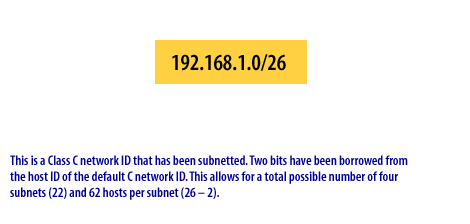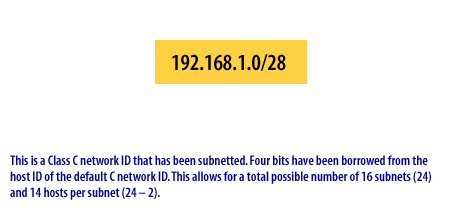| Lesson 7 | IP address subnet requirements |
| Objective | Determine the number of hosts per subnet and number of subnets |
IP Address Subnet Requirements
An IP-routed network design requires that you examine the interrelationship between the number of hosts per subnet and the number of subnets.
An IP-switched network design evaluates only the number of WAN connections.
Your network design must optimize the number of subnets and the number of hosts per subnet. In designing an IP network and selecting the masks required to permit routing, you may be limited by:
- The number of physical subnets that exist.
- The number of logical subnets that you can create.
- The host population on both physical and logical subnets.
Limits on Number of Hosts per Subnet
Consider the following in determining the number of hosts per subnet:
- Network design specifications: Create your network design specifications to meet required performance goals. This requires analyzing the bandwidth utilization, broadcast domain size, routing configuration, distance vector delays, and application data flow requirements.
- Router performance: Evaluate the number of hosts supported by any new or existing routers. To determine the maximum number of hosts supported per subnet, divide the total number of hosts on any LAN by the number of subnets supported by the router(s). If this number exceeds the host capacity of a subnet (as determined by your subnetting scheme) or limits performance (because of a large collision domain), then redesign the network to increase the number of subnets.
Bandwidth Utilization
You can estimate bandwidth utilization by using existing measurements obtained through applications such as the Microsoft Network Monitor
and the Windows 2000 System Monitor. Broadcast or collision domain size is determined by the number of hosts on the network that are on the same side of a layer 2 device. You can evaluate the routing configuration of a network by reading the existing network documentation, or by creating your own documentation. Distance Vector Delays are related to the number of hops data must travel from source to destination, and any delays that take place because of link or router saturation. You can estimate application data flow requirements by calculating the average packet size created by the application and then multiplying that by the number of packets per unit time. Bandwidth utilization is a network statistic and there are a couple factors to take into account when monitoring bandwidth utilization.
First Factor
The first factor is understanding the difference between 1) bandwidth utilization statistic from a single segment and 2) an aggregate of segments.
Administrators often want to know, or are asked the question,
This is because that even on a flat network, there are typically multiple segments, sites, and links that cannot realistically be totaled. For example, if you have 10 segments that you have gathered bandwidth utilization information on for a number of weeks, averaging that data will result in a meaningless number that does not reflect any real statistic. For instance, if nine of the segments have an average utilization of 10 percent, and one segment reaches 95 percent utilization, then "Network Utilization" would be 18.5 percent. This number is of no value because it hides the problem of the single site and increases the utilization of other sites. However, if each segment is monitored separately, the administrator will be able to stay on top of the network, identifying and resolving issues before they even become a problem. Proactive utilization management can save any company significant time and money.
"What is the bandwidth utilization of our network?"The problem is that even on the most basic of networks, this is almost an impossible statistic to determine.
This is because that even on a flat network, there are typically multiple segments, sites, and links that cannot realistically be totaled. For example, if you have 10 segments that you have gathered bandwidth utilization information on for a number of weeks, averaging that data will result in a meaningless number that does not reflect any real statistic. For instance, if nine of the segments have an average utilization of 10 percent, and one segment reaches 95 percent utilization, then "Network Utilization" would be 18.5 percent. This number is of no value because it hides the problem of the single site and increases the utilization of other sites. However, if each segment is monitored separately, the administrator will be able to stay on top of the network, identifying and resolving issues before they even become a problem. Proactive utilization management can save any company significant time and money.
Second Factor
Another factor to take into account when monitoring utilization is the source of bandwidth consumption.
VoIP, database applications, and graphic design programs are all examples of common applications that are known to consume fairly large amounts of network bandwidth. Often, when considering deployment, an administrator feels obligated to increase available bandwidth so that the application will not experience issues. However, the current budget may be tight and purchasing additional bandwidth may require solid justification.
The first step in justifying additional bandwidth is to determine what the current utilization level is on a network segment or link, and second, to trend the actual requirements of the application in a test lab. Simulating usage loads and comparing that information to actual findings to determine if an increase in available bandwidth will be required. Those results may show that it is pertinent to increase bandwidth capacity in order to keep the applications and network running smoothly, and you will have the data to prove it.
On the other hand, you might see a negligible increase in utilization, saving the time and money that would otherwise be spent on an unnecessary upgrade.
DHCP only sends about 4 packets of data so its a tiny amount. We have had sites with more than 100 machines running on the end of a 4Mbit DSL connection with DMVPN over the top, as well as domain traffic, DNS, HTTP etc (no server onsite at all) We never saw any issues, even when rebooting all the machines at 4AM every morning. Stick your DHCP server on a dedicated port, monitor said port with something like PRTG \ MRTG over a 24 hour period and count the packets and bits per second.
DHCP only sends about 4 packets of data so its a tiny amount. We have had sites with more than 100 machines running on the end of a 4Mbit DSL connection with DMVPN over the top, as well as domain traffic, DNS, HTTP etc (no server onsite at all) We never saw any issues, even when rebooting all the machines at 4AM every morning. Stick your DHCP server on a dedicated port, monitor said port with something like PRTG \ MRTG over a 24 hour period and count the packets and bits per second.
- Future growth: Examine the subnet mask to determine if the number of hosts per subnet provides for current needs, performance expectations, and future growth.
Limits on the Number of Subnets
Use the following options to determine the validity of a subnet mask in an IP-routed network:
The following series of images provides further explanation and examples of IP address subnet requirements.
- Subnet for each WAN connection: Examine the network design for any remote connectivity. To support routing, each remote connection requires a subnet.
- Overloaded segments: Evaluate the number of hosts supported by any new or existing router. To determine the minimum number of routers required at any single location, divide the total number of hosts by the number of hosts optimally supported by the router.
- Future growth: Examine the subnet mask to determine if the number of subnets and the number of hosts per subnet provide for growth. If possible, design for an excess of subnets, because router technology usually limits the number of hosts per subnet.
The following series of images provides further explanation and examples of IP address subnet requirements.

11000000.10101000.00000001.00000000 11111111.11111111.11111111.00000000Each bit in the IP address has a corresponding bit in the subnet mask. Those bits that correspond to the '1' in the subnet mask are considered part of the network ID.


Question: What are the characteristics of a Class C network ID that has been subnetted?
When a Class C network ID is subnetted, it is divided into multiple subnets, each with its own unique network ID and subnet mask. The characteristics of a Class C network ID that has been subnetted include the following:
Overall, subnetting a Class C network ID provides many benefits, including increased network capacity, customized network topology, improved security, flexibility, and greater efficiency in managing IP addresses. However, it also requires additional configuration and management, and can increase network complexity. When you configure the TCP/IP protocol on a computer, an IP address, subnet mask, and a default gateway are required in the TCP/IP configuration settings. To configure TCP/IP correctly, it is necessary to understand how TCP/IP networks are addressed and divided into networks and subnetworks.
The next lesson looks at IP configuration methodologies.
When a Class C network ID is subnetted, it is divided into multiple subnets, each with its own unique network ID and subnet mask. The characteristics of a Class C network ID that has been subnetted include the following:
- Increased network capacity: Subnetting a Class C network ID allows for increased network capacity by dividing the network into smaller subnets, each with its own set of addresses. This reduces the number of hosts on each network segment, reducing network congestion and improving network performance.
- Customized network topology: Subnetting allows for a more customized network topology, enabling administrators to design networks that better suit their specific needs. This can include creating subnets for different departments or teams within an organization, or for different types of network traffic.
- Improved security: By dividing a Class C network ID into subnets, administrators can improve network security by controlling access to specific resources within the network. For example, an administrator can configure a firewall to restrict access to certain subnets based on IP addresses, preventing unauthorized access to sensitive data.
- Flexibility: Subnetting allows for greater flexibility in managing IP addresses, as administrators can allocate addresses more efficiently by subnetting the network. This helps to prevent address exhaustion and makes it easier to manage IP address allocations across the network.
- Increased complexity: Subnetting a Class C network ID can also increase network complexity, as it requires additional network configuration and management. Administrators need to ensure that routing tables are updated to reflect the new network topology, and that all devices are configured to use the correct subnet masks.
Overall, subnetting a Class C network ID provides many benefits, including increased network capacity, customized network topology, improved security, flexibility, and greater efficiency in managing IP addresses. However, it also requires additional configuration and management, and can increase network complexity. When you configure the TCP/IP protocol on a computer, an IP address, subnet mask, and a default gateway are required in the TCP/IP configuration settings. To configure TCP/IP correctly, it is necessary to understand how TCP/IP networks are addressed and divided into networks and subnetworks.
The next lesson looks at IP configuration methodologies.
IP Address Subnet Requirements - Exercise
Click the Exercise link below to apply what you know about IP routing among subnets.
IP Address Subnet Requirements - Exercise
IP Address Subnet Requirements - Exercise